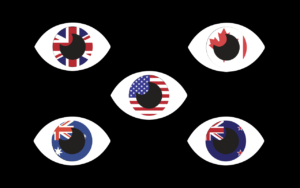
Bernard Quayson (IT-Specialist)
Introduction
In today’s complex geopolitical landscape, military strength plays a crucial role in shaping international relations and maintaining global stability. Nations often form alliances and partnerships to enhance their military capabilities, pool resources, share intelligence, and conduct joint operations. This article aims to shed light on some of the world’s most powerful military alliances and groups, showcasing their collective strength and influence.
North Atlantic Treaty Organization (NATO):

NATO is an intergovernmental military alliance comprising 31 member states – two in North America and twenty-nine in Europe. NATO’s primary objective or the cornerstone of NATO’s founding treaty is Article 5, which states that an attack on one member is considered an attack on all. This principle forms the basis of the alliance’s commitment to collective defense and mutual assistance in the event of an armed attack by a third party. It remains the world’s most formidable military alliance, possessing advanced technology, extensive intelligence sharing, and robust military capabilities.
NATO was established in the aftermath of World War II as a response to the rising tensions between Western democracies and the Soviet Union during the Cold War. The signing of the North Atlantic Treaty on April 4, 1949, marked the formal establishment of NATO, with 12 founding members. The founding members of NATO were Belgium, Canada, Denmark, France, Iceland, Italy, Luxembourg, the Netherlands, Norway, Portugal, the United Kingdom, and the United States.
NATO has added nine times since its formation. Most recently, Finland joined the alliance in April 4, 2023. Sweden is anticipated to become the 32nd member with its Accession Protocol to the North Atlantic Treaty now in the process of being ratified by the existing members. NATO currently recognizes Bosnia and Herzegovina, Georgia, and Ukraine as aspiring members. The combined military of all NATO members includes around 3.5 million soldiers and personnel. Their combined military spending as of 2020 constituted over 57 percent of the global nominal total. NATO Headquarters is located in Brussels, Belgium.
United States-Led Alliances:
Five Eyes (FVEY):

The Five Eyes alliance, also known as FVEY, was established during the post-World War II era. Its origins can be traced back to the “UKUSA Agreement,” a multilateral intelligence-sharing agreement signed between the United States and the United Kingdom in 1946. However, it was officially formalized as the “Five Eyes” alliance in 1955. The alliance consists of the United States, the United Kingdom, Canada, Australia, and New Zealand, and is focused on signals intelligence (SIGINT) cooperation and intelligence sharing among its members. This alliance enables close cooperation in cybersecurity, counterterrorism, and defense capabilities, making it a potent force in the global intelligence community.
United States-Japan Security Treaty:
The alliance between the United States and Japan is rooted in the United States-Japan Security Treaty of 1960. It serves as a cornerstone for stability and security in the Asia-Pacific region, with the United States maintaining a significant military presence in Japan, the alliance acts as a deterrent against regional threats and supports peace and stability in East Asia.
The alliance between the United States and Japan is rooted in the United States-Japan Security Treaty of 1960. It serves as a cornerstone for stability and security in the Asia-Pacific region, with the United States maintaining a significant military presence in Japan, where the alliance acts as a deterrent against regional threats and supports peace and stability in East Asia.
Shanghai Cooperation Organisation (SCO):

Formed in 2001, the SCO is a Eurasian political, economic, and security alliance. Its member states include China, Russia, India, Pakistan, Kazakhstan, Kyrgyzstan, Tajikistan, and Uzbekistan. While primarily focused on regional security, the SCO’s military strength stems from the combined forces of China and Russia. It serves as a counterbalance to Western alliances and has the potential to influence regional dynamics.
Collective Security Treaty Organization (CSTO):

The Collective Security Treaty Organization (CSTO) stands as a vital alliance in the realm of collective security and cooperation among its member states. Founded in 2002, the CSTO comprises post-Soviet nations, including Russia, Armenia, Belarus, Kazakhstan, Kyrgyzstan, and Tajikistan. With a primary focus on regional defense and security, the CSTO plays a critical role in ensuring stability and safeguarding the interests of its member states.
Conclusion
In an interconnected world that demands collaboration and resilience, the power of strong military alliances remains undeniable, reminding us that together, nations can overcome challenges and build a more secure and prosperous future for all.


Can you be more specific about the content of your article? After reading it, I still have some doubts. Hope you can help me.
I will do my best. thanks